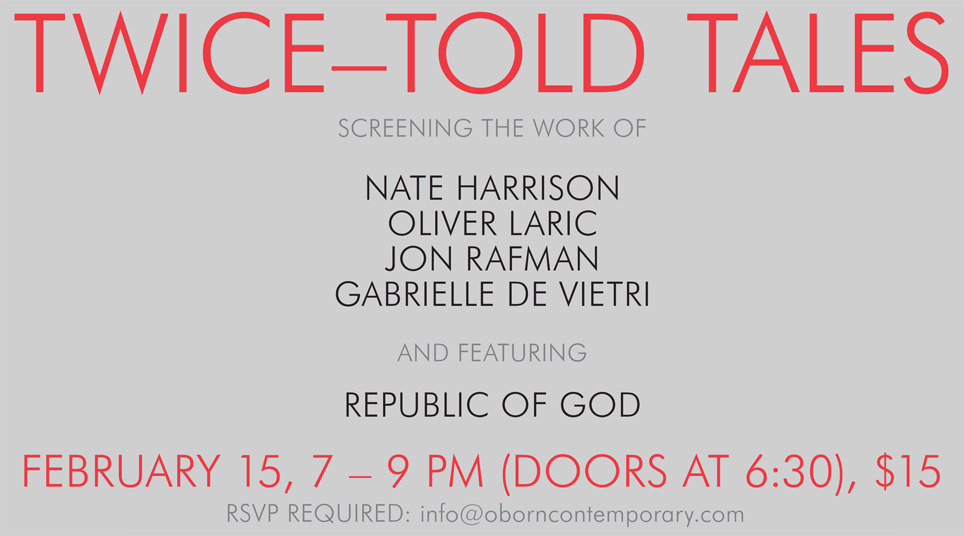Twice – Told Tales
February 15, 2012, 7–9 PM
about the screening
Twice – Told Tales is the first event of O'Born Contemporary's newest programming addition: a screening series. Join us in the
gallery the evening of February 15 for the programming of five works by both local and international artists, with a Q & A led by O'Born
Contemporary Co – Director Lili Huston – Herterich to immediately follow.
Because of its durational property, video is most often used for storytelling: narrative iterations of the medium dominate entertainment,
media, advertising, and even home video. Twice- Told Tales features five video works that embody the contemporary narrative. By
acknowledging the derivative essence of storytelling, these artists build their tales with existing sources, culminating in final works
that are boundlessly referential and insightful. The videos collect, organize, and re-present fragments as a new whole, one unafraid of
crumbling to contribute to a future other.
about the work
By paralleling the reclamation of historical iconography and contemporary digital copies, Oliver Laric's Versions (2010) suggests a liberating
thought: simply, that "unoriginality" is in fact progress. At one point, the narrator explains, "five people interpret an action, and each interpretation
is different because, in the telling and the retelling, the people reveal not the action but themselves." This embrace of the exponential evolution of
imagery summarizes the patterns of inherited storytelling, and contextualizes the current age of digital reproduction.
Jon Rafman's You, the World, and I is a modern day version of Orpheus' sad tale of loosing his beloved Eurydice. Constructed from found images
and videos from 3D geographical renderings, Google Earth, and Google Street View, You, the World, and I becomes a nonspecific narrative for the contemporary
self. In his writing on this work, Rafman asks: "By getting as close as possible to the world through technology, has our narrator not unwittingly distanced
himself from this world?"1 This distinguishing distance from virtual and physical reality resembles the crucial distance good storytelling achieves; a gifted
narrator can lull us into the most fantastic of worlds, allowing us to forget, or even question, what we know as real.
Australian artist Gabrielle de Vietri also adapts contemporary imagery as a means to an imaginary end. With Captcha, the artist narrates a fantasy story
guided by words generated for CAPTCHA online security tests. The humorous and sincere reclamation of the gibberish text demonstrates a natural storyteller inspired
by digital mundane, utilizing the medium of digital video to accentuate the contrast between sterile online security tests and a chimerical saga.
Nate Harrison's Aura Dies Hard offers a critical look at the evolution and dematerialization of video art. Using his own unauthorized collection of
historical and contemporary works, Harrison discusses the evolution of video dissemination, closing with the suggestion that the re-materialization of video art through
bootlegging and multiple dubbing has unintentionally supported the video's lasting historical role. Therefore, historically relevant video work is dependent on the
iterations and copies (literal or interpretive) that come of it, just as a classic fable is dependent on generations of its narrators.
Republic of God closes Twice – Told Tales with a story gone stale. Beginning with a sarcastic, almost omniscient booming voice promoting a
politically controversial nation, the work willingly crumbles into an inversion of itself. Using video collage techniques to illustrate the vulnerability of propaganda
and the strength of visual narration, Republic of God celebrates the transformation of truth, and reclaims imagery and ideas otherwise condemned.
1 Excerpted from Jon Rafman's artist statement, 2010.
